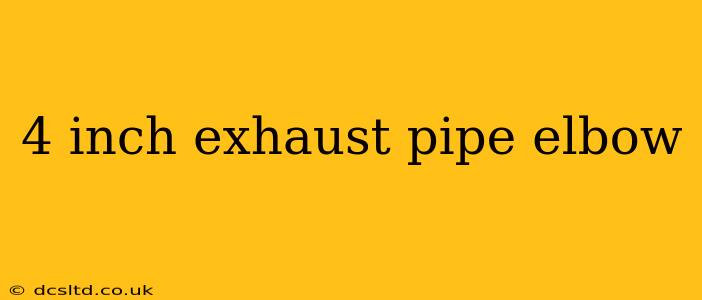Finding the right 4-inch exhaust pipe elbow can be crucial for your vehicle's performance and longevity. This guide dives deep into everything you need to know, from choosing the correct material and angle to understanding different applications and potential issues. Whether you're a seasoned mechanic or a DIY enthusiast, this information will empower you to make informed decisions.
What are the Different Types of 4-Inch Exhaust Pipe Elbows?
Several factors influence the type of 4-inch exhaust pipe elbow you need. Let's break down the key considerations:
Material:
-
Aluminized Steel: This is a popular choice due to its balance of affordability and durability. The aluminum coating offers corrosion resistance, making it suitable for many applications. However, it's not as resistant to high heat as stainless steel.
-
Stainless Steel: Offering superior corrosion resistance and heat tolerance, stainless steel elbows are more expensive but last considerably longer, especially in demanding environments. They're ideal for high-performance vehicles and applications where longevity is paramount.
-
Mandrel-Bent vs. Crush-Bent: Mandrel-bent elbows are formed using a mandrel (a shaped tool) which creates a smooth, consistent bend without crushing the pipe. This improves exhaust flow and prevents turbulence. Crush-bent elbows, while cheaper, create a less smooth interior, potentially restricting exhaust flow.
Angle:
Exhaust pipe elbows come in various angles, typically measured in degrees. Common angles include 45-degree, 90-degree, and 180-degree (U-bend) elbows. The angle you need depends entirely on your specific exhaust routing requirements.
How to Choose the Right 4-Inch Exhaust Pipe Elbow?
Choosing the right elbow involves careful consideration of several factors:
-
Your Vehicle's Make and Model: The specific requirements will vary depending on your vehicle's design and the existing exhaust system. Consulting a workshop manual or exhaust diagram is always recommended.
-
Intended Use: Are you repairing an existing system, upgrading for performance, or building a custom exhaust? This will dictate the material and angle needed.
-
Exhaust System Layout: Carefully map out your exhaust routing to determine the necessary angles and elbow types. A precise layout minimizes issues and ensures proper fitment.
-
Budget: Stainless steel elbows are more expensive than aluminized steel, so your budget will play a role in material selection.
What are Common Problems with 4-Inch Exhaust Pipe Elbows?
Potential issues include:
-
Corrosion: Aluminized steel elbows are susceptible to rust and corrosion, particularly in wet climates. Regular inspections and maintenance are essential.
-
Leaks: Improper installation or damaged elbows can lead to leaks, resulting in reduced performance and potential safety hazards.
-
Restrictions: Crush-bent elbows can restrict exhaust flow, impacting engine performance. Opt for mandrel-bent elbows for optimal flow.
-
Improper Fitment: Selecting an elbow with the wrong angle or diameter will lead to difficulties during installation and potential performance issues.
What is the Difference Between a 4-Inch Exhaust Pipe Elbow and Other Sizes?
The size of the exhaust pipe elbow directly impacts exhaust flow. A larger diameter, like 4 inches, allows for greater exhaust gas flow, generally beneficial for high-performance engines. Smaller diameters restrict flow, potentially hindering performance. The correct size is critical for optimal engine performance and to prevent back pressure buildup.
Where Can I Find a 4-Inch Exhaust Pipe Elbow?
4-inch exhaust pipe elbows are available from various automotive parts suppliers, both online and in brick-and-mortar stores. Many online retailers specialize in exhaust components and offer a wide selection of materials and angles. Always compare prices and read reviews before purchasing.
This comprehensive guide helps you navigate the world of 4-inch exhaust pipe elbows. Remember, proper selection and installation are key to ensuring optimal performance and longevity of your vehicle's exhaust system. If you're unsure about any aspect of the process, consult a qualified mechanic.
